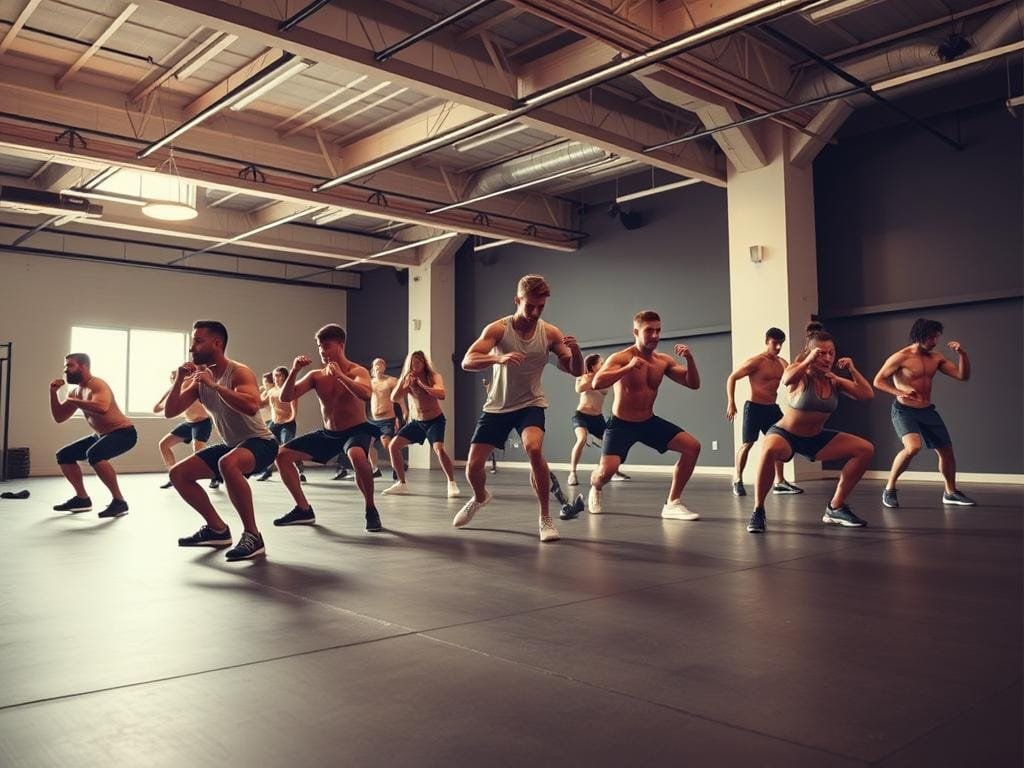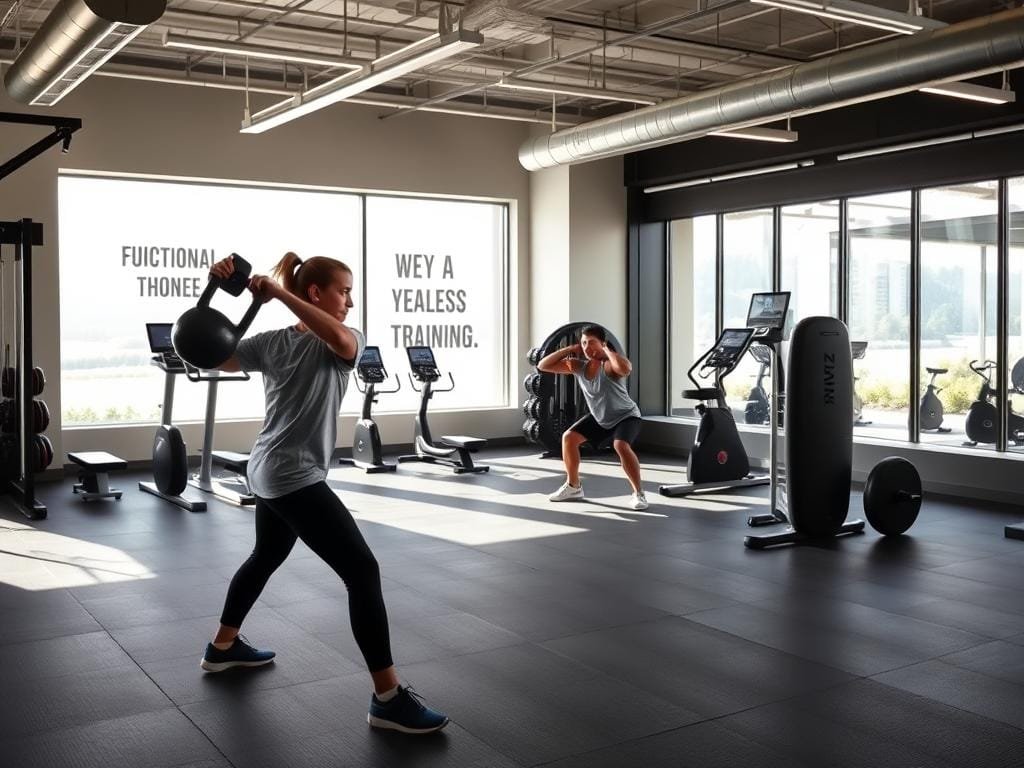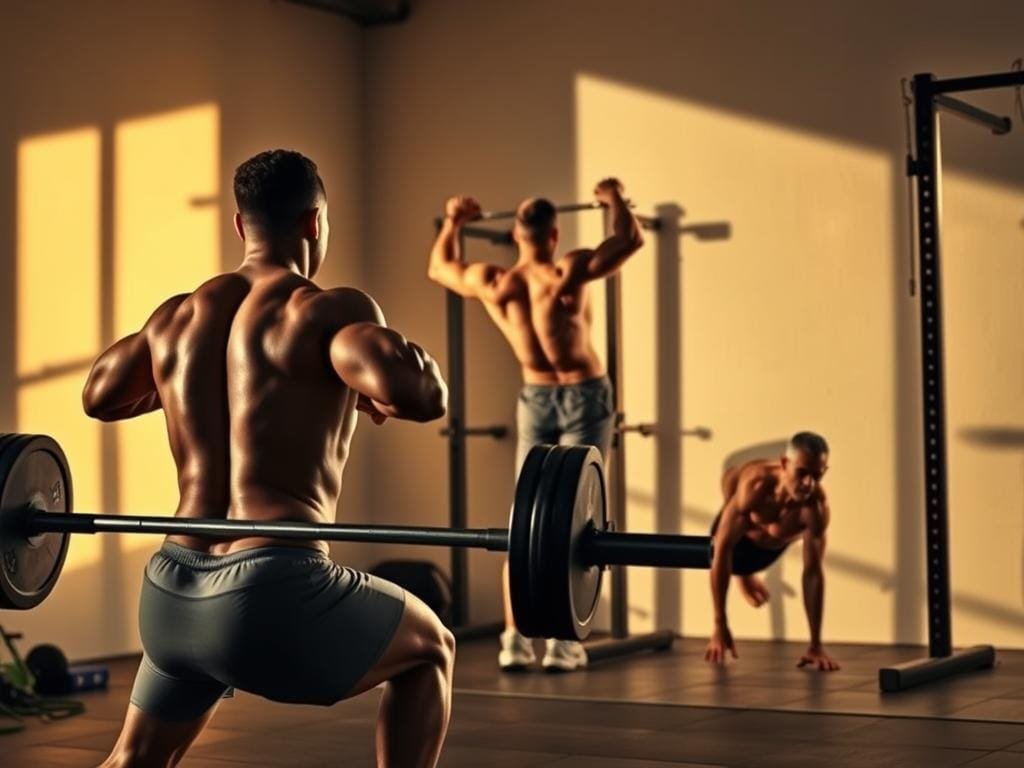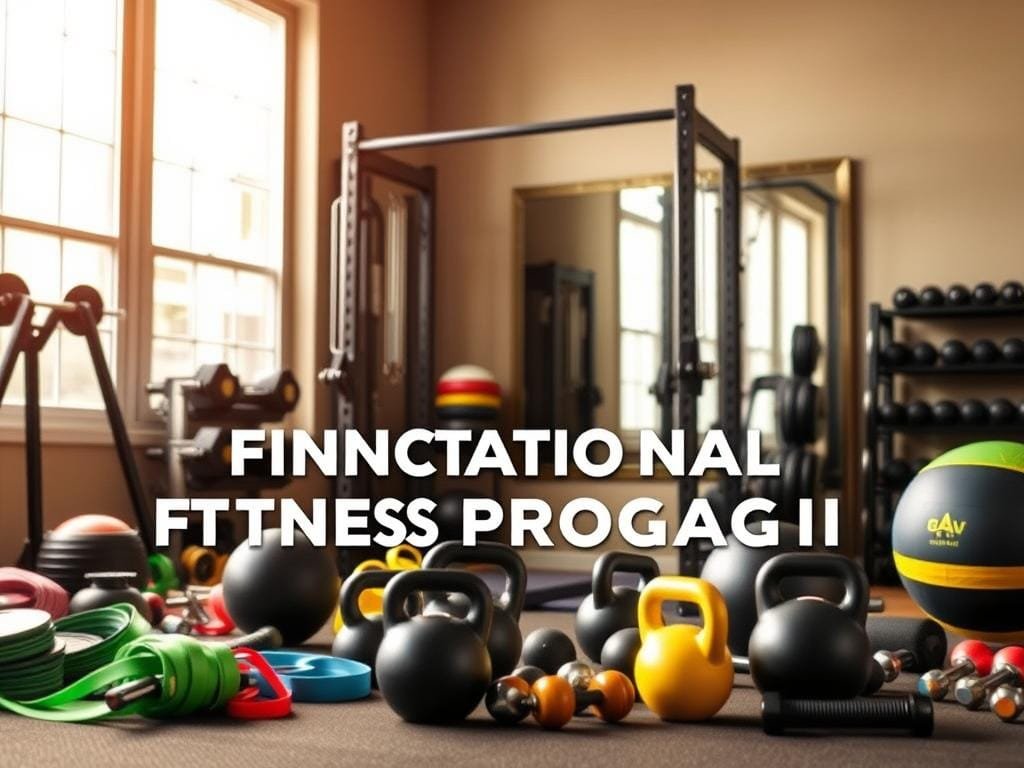Did you know that adding functional exercises to your day can boost your life quality? These exercises help your muscles work together. This makes everyday tasks easier and lowers injury risk.
Functional fitness makes your workouts better for real life. It helps you move like you do every day. This means carrying groceries or playing with kids becomes easier. For more on adding functional fitness to your exercise routine, check out the benefits and tips to start.
Table of Contents
Key Takeaways
- Functional fitness improves daily life activities by boosting strength, balance, and flexibility.
- Adding functional exercises to your routine can lower injury risk.
- Examples of functional exercises include squats, lunges, deadlifts, push-ups, planks, and rows.
- Start slow with correct form and focus on quality over quantity.
- Minimal equipment is needed for functional fitness training.
Understanding Functional Fitness Principles
Functional fitness trains your body for everyday activities. It makes daily tasks easier and safer. By doing exercises that mimic real-life actions, it boosts strength, balance, and flexibility.
The Philosophy Behind Functional Training
Functional training makes your body ready for daily tasks. It uses exercises that work many muscles at once. This leads to balanced strength and better flexibility.
For example, lifting groceries or playing with kids works your whole body. Functional fitness gets you ready for these activities by strengthening muscles and improving coordination.
How It Differs from Traditional Gym Workouts
Functional fitness is different from gym workouts that focus on single muscles. It takes a holistic approach. It uses various movements to boost your fitness and prepare you for life’s demands.
To see the difference, let’s look at traditional strength training versus functional fitness:
| Aspect | Traditional Strength Training | Functional Fitness |
|---|---|---|
| Focus | Isolating specific muscle groups | Working multiple muscle groups simultaneously |
| Exercises | Machine-based exercises like leg press | Movements like squats, lunges, and deadlifts |
| Benefits | Improved muscle mass in targeted areas | Enhanced overall strength, balance, and flexibility |
Functional fitness does more than build strength. It improves your overall physical ability. For more on its benefits and techniques, check out Understanding Functional Fitness: Benefits and Techniques.
The Science of Movement in Functional Fitness
Understanding the science behind functional fitness is key. It shows how it boosts your daily tasks and reduces injury risk. Functional fitness makes you more efficient and safer in your daily activities.
Functional fitness trains your body to move like you do every day. It’s different from traditional strength training, which isolates muscles.
Movement Patterns vs. Isolated Exercises
Functional fitness focuses on movement patterns, not just single exercises. Movement patterns use many joints and muscles together. For example, a squat works your legs, glutes, and core, getting you ready for sitting or standing.
Isolated exercises, like bicep curls, target one muscle. They’re useful but don’t prepare you for daily movements.

Neurological and Muscular Integration
Functional fitness also links your neurological and muscular systems. It strengthens muscles and improves movement control. This is key for better physical performance and injury prevention.
Training your body as a whole improves balance, agility, and quickness. This makes you more capable in everyday life.
| Movement Pattern | Muscle Groups Involved | Functional Benefit |
|---|---|---|
| Squat | Legs, Glutes, Core | Improves ability to sit and stand |
| Lunge | Legs, Glutes, Core | Enhances balance and stability |
| Push-up | Chest, Shoulders, Triceps, Core | Strengthens upper body and improves posture |
By choosing functional fitness, you build a balanced and capable body. This prepares you for the challenges of daily life.
Key Benefits of Functional Training
Functional training does more than just improve your gym performance. It boosts your daily activities and health. It focuses on real-life movements, building strength, flexibility, and coordination for everyday tasks.
Improved Daily Performance
Functional training makes daily tasks easier, like carrying groceries or playing with kids. This type of training boosts your functional strength. It helps you move better and more efficiently in your daily life.
Exercises like squats, lunges, and step-ups improve your stair climbing and getting up from a seat. Adding these to your routine boosts your mobility and independence.
Injury Prevention and Rehabilitation
Functional training is great for preventing injuries and helping with recovery. It strengthens muscles and boosts flexibility. This reduces injury risks during daily activities or sports.
It also aids in recovery by using controlled, functional movements. This is very helpful for those recovering from injuries or surgery.
Total Body Conditioning
Functional training gives you a full-body workout, improving your fitness and conditioning. This holistic exercise approach builds a strong, balanced body. It enhances your health and well-being.
By doing a variety of functional exercises, you get a workout that’s good for your heart, metabolism, and muscles. It’s a total body workout.

Essential Movement Patterns for Real-Life Strength
Understanding and mastering essential movement patterns is key to functional fitness. These patterns are the foundation of daily activities and athletic performance. They help you move efficiently and keep your strength up.

Push and Pull Movements
Push and pull movements are vital for everyday tasks, like opening doors or pulling yourself up. Mastering these movements boosts your upper body strength. It also improves your functional fitness. Examples include push-ups, rows, and presses and pulls with free weights or bands.
Squat and Hinge Patterns
Squatting and hinging are key for your lower body and core. Squats work your quadriceps, hamstrings, and glutes. Hinges, like deadlifts, target your back muscles. These movements are essential for lifting objects or standing up from a seat.
Rotation and Anti-Rotation
Rotation and anti-rotation movements are important for power and stability. Rotational movements, like in throwing or golf swings, engage your core. They improve your athleticism. Anti-rotation exercises stabilize your core and are key for balance in various activities.
Locomotion and Carrying
Locomotion includes walking, running, or climbing, which are essential for daily life and sports. Carrying objects, like groceries or equipment, requires strength, coordination, and balance. Adding locomotion and carrying exercises to your routine boosts your functional fitness and real-life strength.
By focusing on these essential movement patterns, you can create a well-rounded fitness program. It will improve your strength, enhance daily performance, and lower injury risk. Including a variety of exercises that target these patterns prepares you for daily life and sports.
Setting Up Your Functional Fitness Program
To start a functional fitness journey, setting up a good program is key. It helps you build strength for everyday life. You need to follow a few steps to make your training fit your needs and goals.
Assessment of Current Abilities
The first step is to check where you stand now. Look at your strength, flexibility, endurance, and overall health. A good check-up will show you what to work on, helping you plan better.
Start with basic movements like squats, lunges, push-ups, and rows. Keep track of how you do to see how you improve over time.
Goal Setting for Real-Life Strength
After checking your current level, set goals that are realistic and reachable. Make sure your goals are clear, measurable, and fit your lifestyle. For example, if you need to lift heavy at work, focus on exercises for your back, legs, and core.
Think about what you want to get better at. Do you want to be more athletic or play with your kids without getting tired? Having specific goals will help guide your training.
Equipment Needs vs. Bodyweight Options
Next, decide if you’ll use equipment or bodyweight exercises. Both have their benefits. Bodyweight exercises are easy to do anywhere, while equipment adds variety and challenge.
Here’s a comparison to help you decide:
| Exercise Type | Equipment Needed | Benefits |
|---|---|---|
| Squats | Bodyweight or Barbell | Strengthens legs and glutes |
| Push-ups | Bodyweight | Improves upper body strength |
| Rows | Resistance Bands or TRX | Targets back and arm muscles |
For more detailed routines, check out Muscle and Fitness. They have programs for different needs.

By assessing your abilities, setting goals, and choosing the right tools, you can make a program that boosts your strength and wellness.
Beginner’s Functional Workout Plan
A good beginner’s workout plan is key for real-life strength and fitness. It should include exercises that focus on basic movements. Also, a weekly schedule and warm-up and cool-down routines are important to avoid injuries and help in recovery.
Foundational Movements and Form
Foundational movements are the base of functional fitness. These include squats, lunges, pushes, pulls, and rotations. Learning the right form for these movements is vital for effective training and safety. For example, a correct squat keeps your back straight and engages your core.
Lower yourself down until your thighs are parallel to the ground. You can find more details on proper form in various workout plans.
Sample Weekly Schedule
A beginner’s workout plan might include three to four training days, with one day of rest in between. For example, train on Monday, Tuesday, Thursday, and Friday, resting on Wednesday, Saturday, and Sunday. Each session should last 45 minutes to an hour.
Include a mix of upper body, lower body, and core exercises. For more on creating a workout plan, check this resource.
- Monday: Upper body strength training (push-ups, rows, etc.)
- Tuesday: Lower body strength training (squats, lunges, etc.)
- Thursday: Core and rotational training (planks, Russian twists, etc.)
- Friday: Full-body circuit training
Proper Warm-Up and Cool-Down Protocols
A good warm-up includes 5-10 minutes of light cardio and dynamic stretching. This prepares your muscles for exercise. Examples are jogging in place, arm circles, and leg swings.
After working out, a cool-down with static stretches helps reduce soreness and improves flexibility. Focus on stretches for the major muscle groups you used.
By sticking to a beginner’s workout plan, you build a strong fitness base. This reduces injury risk and boosts performance.
Intermediate and Advanced Progression Strategies
Getting to intermediate and advanced levels in functional fitness needs careful planning. You must challenge your body as you get better at basic movements. It’s key to add new complexities to keep improving in your exercise routine.
Adding Complexity to Basic Movements
To move forward, add complexity to the basic moves you know well. You can do this by changing how fast you move, increasing how far you go, or adding more moves to a sequence. For instance, you can make a squat harder by pausing at the bottom or by doing a squat-to-press.
- Change tempo: Slow down or speed up your movements.
- Increase range of motion: Deepen your squats or lunges.
- Add additional movements: Combine squats with presses or rows.
Incorporating Instability and Resistance
Adding instability and resistance is a great way to level up your fitness. Use tools like resistance bands, stability balls, or do exercises on uneven surfaces. This makes your muscles work harder, boosting your health and stability.
| Tool | Exercise Example | Benefit |
|---|---|---|
| Resistance Bands | Banded Squats | Increased resistance throughout the movement |
| Stability Ball | Ball Plank | Improved core stability and balance |
| Uneven Surfaces | BOSU Ball Squats | Enhanced balance and proprioception |
Creating Challenging Circuit Workouts
Circuit workouts are a great way to push yourself and help with weight loss. Mix strength, endurance, and agility exercises to keep your workouts interesting and tough. Make sure to eat right to support your increased activity.
When setting up a circuit, remember these tips:
- Pick 4-6 exercises that work different muscles.
- Do each exercise for 30-60 seconds.
- Rest for 15-30 seconds between each exercise.
- Do 2-3 rounds of the circuit.
By using these strategies, you’ll keep challenging yourself and reach your gym goals.
Functional Fitness for Specific Life Demands
Functional fitness is great because it fits your life needs. It helps you get better at sports, meet job demands, or stay fit as you age. You can customize it to fit your goals.
Training for Sports Performance
Athletes can really benefit from functional fitness. It boosts their strength, agility, and endurance. The training mimics the sport’s movements, making them better at it.
- Improved Power and Speed: Box jumps and resistance band sprints help with power and speed.
- Enhanced Agility: Drills for quick direction changes boost agility and reaction time.
- Better Endurance: Burpees and jump squats increase stamina and endurance.
Workouts for Occupational Requirements
Functional fitness is key for jobs that are tough on the body. It improves job performance and lowers injury risk. Programs are made to match the job’s tasks and movements.
| Occupation | Functional Fitness Focus | Example Exercises |
|---|---|---|
| Construction Worker | Lifting, carrying, and climbing | Deadlifts, farmer’s walks, step-ups |
| Firefighter | Strength, endurance, and agility | Kettlebell swings, rope climbs, shuttle runs |
| Nurse | Core strength, flexibility, and endurance | Planks, leg raises, wall squats |
Age-Specific Functional Training
Functional fitness is good for everyone, no matter their age. It keeps older adults mobile and independent. For the young, it boosts fitness and athleticism.
- For Older Adults: Focus on balance, flexibility, and low-impact exercises like tai chi and water aerobics.
- For Younger Individuals: Use high-intensity interval training (HIIT) and plyometric exercises to improve strength and agility.
By making your fitness program fit your life, you get stronger and perform better in real life.
Common Mistakes in Functional Training and How to Avoid Them
Functional training can be tricky. It’s designed to help you do everyday tasks better and get fitter. But, it needs the right technique and plan to work well.
Form and Technique Errors
Keeping the right form and technique is key in functional training. Wrong form can cause injuries and make your workouts less effective. Some common mistakes include:
- Using too much weight, which can hurt your form.
- Not using your core or keeping your back straight during exercises.
- Moving too fast, losing control in the process.
To avoid these mistakes, focus on slow and controlled movements. Make sure to engage your core and keep good posture. Working with a qualified trainer can also help you improve your form.
Programming Pitfalls
Getting your functional training program right is just as important as doing the exercises right. Common mistakes include:
- Not changing your workout often, leading to a plateau.
- Working too hard or too little, not balancing effort and rest.
- Not setting clear, reachable goals for your training.
To avoid these mistakes, change your workout routine regularly. Also, listen to your body and adjust how hard you’re working based on how you feel and recover.
Recovery and Progression Issues
Recovery is a big part of any training, including functional training. Problems with recovery and moving forward can slow you down and lead to burnout or injury. Common problems include:
- Not giving your body enough time to recover between hard workouts.
- Not making exercises harder enough, or making them too hard too fast.
To fix these problems, make sure to use recovery techniques like stretching and getting enough sleep. Also, slowly make exercises more challenging by adding more intensity, volume, or complexity over time.
Knowing these common mistakes and how to avoid them can help you get the most out of your functional training. This way, you can reach your fitness goals more effectively.
Integrating Functional Fitness with Other Training Styles
Mixing functional fitness with other training styles makes your workout better. It helps you cover all bases of physical fitness. This way, you get a full workout that improves your health.
Combining with Cardiovascular Training
Adding cardio to your functional fitness boosts endurance and stamina. Try running, cycling, or swimming with your functional exercises. For instance, add burpees or jump squats to your routine.
- Try high-intensity interval training (HIIT) for better heart health.
- Use treadmills or ellipticals in your workouts.
- Switch between functional and cardio exercises to keep your heart rate up.
For more tips on mixing training styles, check out Graham Fitness Blog. It shows how to blend different methods for the best results.
Complementing Traditional Strength Training
Functional fitness adds to traditional strength training. It focuses on exercises that boost strength, flexibility, and coordination. This mix improves muscle strength and endurance.
Key benefits of combining functional fitness with strength training include:
- Improved muscle balance and overall strength.
- Enhanced coordination and movement patterns.
- Better preparation for real-life physical demands.
Functional Mobility and Flexibility Work
Adding mobility and flexibility exercises to your routine boosts range of motion. It also lowers injury risk. Use dynamic stretches and mobility drills that match your functional movements.
By mixing functional fitness with other training, you get a balanced workout. It improves your fitness and prepares you for daily life challenges.
Conclusion: Building Lasting Real-World Strength
Functional fitness is a smart way to exercise that makes you better at everyday activities. It helps you get stronger and healthier. This training boosts your fitness and wellness by making you more capable in daily tasks.
Functional fitness means living a healthy lifestyle that prepares you for life’s challenges. It’s about doing exercises that really help you in your daily life. As you keep working on your fitness, you’ll get stronger and less likely to get hurt.
Adding functional fitness to your routine is a smart choice for your health. It helps you build strength that lasts, making daily tasks easier. Start your fitness journey today and see how a healthier, more active life can change you.

